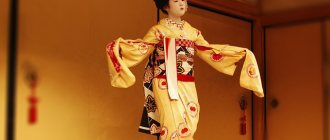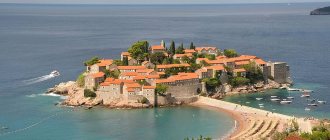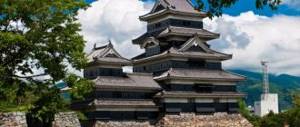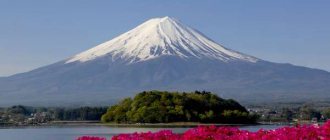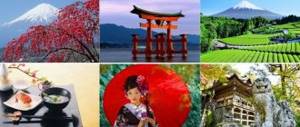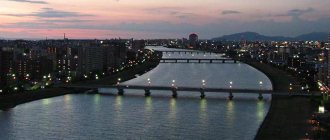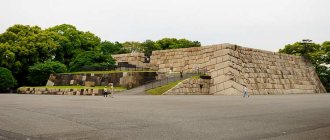The famous Tokyo Imperial Palace is an entire architectural complex located in the very center of the Japanese capital. It is the pride and national heritage of the entire Japanese people. The area of the imperial complex occupies about 741 hectares of land. Nearby are the courthouse, the Japanese parliament, the building of the ministry and the Japanese embassy.
The Imperial Palace is like a magnificent oasis located in the very heart of a huge metropolis.
Currently, it houses the residence of the Japanese Emperor Akihito. The palace building is under 24-hour security.
Therefore, it is not possible to visit the palace. Tourists can only admire it from afar. Only the Eastern Garden is open to the public. But not every day either. Only in honor of the New Year celebrations, visitors are allowed to stroll through all the gardens of the palace and see the imperial family.
History and interesting facts
After 1457, Edo Castle, owned by the samurai Dokan, appeared on the territory. But in the 17th century, this building came into the possession of the shogunates (or rulers of Japan) from the Tokugawa dynasty, whose reign spanned the 17th-19th centuries.
But with the advent of modern times, a civil war broke out on the islands. As a result, the shogunates were overthrown and direct imperial rule was restored to the people of Japan. At the same time, this city was proclaimed the capital of the state. The castle, which belonged to the shoguns, became the residence of the reigning monarchs.
For more than a century and a half, it had to be restored more than once:
- a few years after the restoration of the monarchy, the castle burned to the ground, and restoration took more than a decade;
- at the end of the 19th century, a lightning strike destroyed the high palace tower;
- At the end of World War II, the palace complex was almost completely destroyed by Allied planes.
The Japanese tradition involves the construction of wooden buildings. This material was also used in construction. But due to numerous fires and destruction, after the end of World War II, the authorities decided to use reinforced concrete to restore the complex. As a result, after a large-scale restoration, several buildings appeared on the site of one castle, interconnected by gallery rooms.
3Inuyama Castle
This ancient fortress is located in the town of the same name in Aichi Prefecture. The castle's foundations were supposedly laid by Oda Hirohika in 1440 on a hill overlooking the Kiso River that separates Gifu and Aichi prefectures. The modern appearance of the castle was achieved during the reconstruction by Oda Nobuyasu in 1537.
Inuyama Castle was the heart of the Naruse clan until the Meiji period, until it was confiscated. However, after a strong earthquake in 1891, the fortress was practically destroyed and returned to the Naruse clan for restoration. Now the castle is in excellent condition after a major renovation in 1965 and is open to tourists.
Architecture and interiors
It occupies more than three hectares. The architectural ensemble is a mixture of buildings built in traditional Japanese and European styles. This feature is clearly evident in the main building. Consisting of three floors (one is located underground), it was built from reinforced concrete, but retained the traditional Japanese architecture, which involves the use of wooden structures in interior design.
Inside the former castle there are:
- office;
- dining rooms;
- rooms where honored guests are received;
- banquet hall and other rooms.
Consists of two parts, separated by two bridges. These structures are visible from the central square of the architectural complex. To the side of the main building there are:
- a museum whose collection consists of more than 10 thousand exhibits;
- three palace sanctuaries where the sacred necklace of the imperial court is kept;
- laboratory of the Japanese ruler;
- a concert hall erected in honor of the emperor's wife in the second half of the 20th century.
An architectural park has been created on the territory of the complex, into which old buildings from the 16th to 19th centuries, built in the traditional Japanese style, are brought.
1Matsumoto Castle
This ancient Japanese castle, located in Nagano Prefecture, is the opposite of Himeji Castle. It was also nicknamed “Black Raven” because of the walls’ characteristic color. It was built as a fortress in 1504. For 280 years it was ruled by the Matsumoto clan.
During the Meizdi Restoration, the castle was under threat of demolition and was sold at auction. Over five centuries, it has repeatedly undergone various reconstructions and rebuildings, and in 2011 it was damaged by an earthquake. However, its proximity to Tokyo has made it the most popular tourist destination. Matsumoto Castle has become a national treasure and is open to the public.
These castles illustrate Japan's rich culture. Each fortress preserves a centuries-old history of clans, confrontations, battles for power and turning points.
What to see?
Due to the fact that most of the grounds of the Imperial Palace in Tokyo are closed to visitors throughout the year, a limited part of the architectural structure can be viewed here on normal days. The capital complex is interesting because the area is surrounded by greenery, which is uncharacteristic of the rest of the city.
On ordinary days, during a walk, it is worth visiting the Eastern Gardens, which partially offer views of the bridge and other structures. The Tokyo ensemble will be interesting in winter, when the sakura blossoms.
Eastern Gardens of the Imperial Palace
Fishimi-yagura Watchtower
"Double Bridge" Nijubashi
Eastern Gardens of the Imperial Palace
The Eastern Gardens are one of the few parts that are open to the public year-round. Moreover, earlier the defense circles of Edo Castle were located here. The only fortification structure that has survived to this day and was previously a large tower, today looks like a wide platform.
In another part of the Eastern Gardens there are maple trees, which are especially beautiful in the fall when the leaves turn bright red or yellow. Along the artificial reservoir, also organized on the territory of former fortifications, there is a garden with irises. You can see carp in the muddy water of the pond.
A little to the side of the iris garden there is a tea house, which serves a decorative function. On the territory of the Eastern Gardens there are mainly trees native to Japan. This part, despite the abundance of visitors, stands out from the rest of the city with its expressive cleanliness.
Banse Guard Gate
The guard gate is one of the few buildings built several centuries ago. Previously, guards were stationed here to inspect visitors wishing to have an audience with the ruler of Japan.
Fishimi-yagura Watchtower
The three-level watchtower is designed in traditional Japanese style, with curved roofs, and stands on a dark stone fortress wall. The walls of the structure are bright white. The tower first appeared in this place in the second half of the 17th century. Over the following centuries, Fishimi-yagura was rebuilt and repaired several times.
This tower is considered the most beautiful structure. Fishimi-yagura, thanks to special architectural solutions, is well protected on all sides, and seems to float above neighboring buildings and trees.
"Double Bridge" Nijubashi
Nijubashi is a double-arch bridge made of metal. The structure was erected in 1888 and serves as the main entrance to the territory. This bridge stands out due to its openwork lattice and decorative lanterns. From Nijubashi there is a view of the Fishimi-yagura watchtower and a number of other buildings of the Tokyo architectural ensemble.
Hanzo Gate
Ancient pagoda
Imperial Laboratory and Sanctuaries
There are three sanctuaries on the territory:
- in the first rest the souls of the deities of Heaven and Earth, the guardians of the palace;
- in the second the souls of past emperors rest;
- the third contains a divine mirror, which is the personification of the goddess Amaterasu and one of the main relics of Japanese rulers.
- To the side of the three shrines is the emperor's laboratory.
"Peach Orchard Music Hall"
This hall was built in the 60s of the last century, in honor of the emperor's wife. Concerts are regularly held here for the family of the rulers of Japan with the participation of both local and famous composers. However, more often small national groups perform here. The hall hosts events to which ordinary people are also allowed.
Ancient pagoda
The ancient pagoda is a remnant of the shogun's palace, built before the restoration of power. The structure was built in classic Japanese style, with curving roofs and protruding wooden canopies.
Imperial Palace in Tokyo
Video: Imperial Palace in Tokyo
Basic moments
The Imperial Palace is adjacent to government institutions - parliament, ministries, courts, embassies, as well as popular tourist attractions - Nippon Budokan Arena, Tokyo Station, Yasukuni Shrine, Tokyo Forum. The snow-white building with a pointed roof, surrounded by fluffy pine trees, resembles an “oasis of calm” in the heart of a densely populated metropolis. The castle has two above-ground floors and one underground. It is built from modern reinforced concrete structures, but using elements of traditional architecture. The interiors of the Imperial Palace in Tokyo are also designed in Japanese style and richly decorated with precious wood. There are several halls for audiences and receptions, banquet and dining rooms, an office for the emperor and other premises.
The Imperial Palace has been surrounded by wide protective moats with water and massive walls for many centuries. They seem to fence off the home of the Sun's governor on Earth from city noise. Nearby lies the territory of a picturesque natural oasis - the Internal and Eastern Gardens. Unlike the famous castles of Europe, there is no ostentatious wealth and luxury in the Japanese Imperial Palace; its elegant architecture is emphatically strict and simple.
Today, the residence of the Emperor of Japan, Akihito, is located here. In this regard, the territory of the palace complex is carefully guarded, no metro lines are built under it, and the ground area is closed to helicopters.
Unfortunately, tourists can only admire the Imperial Palace from afar. You won't be able to walk along the adjacent park alleys either. Visitors can only enter the East Garden (Koyo Higashi Gyoen), but it is worth keeping in mind that this too is closed on Mondays and Fridays, as well as any other days when the Imperial Family participates in ceremonial events.
However, this rule has exceptions: twice a year, after the New Year celebrations - January 2 and on the Emperor's Birthday - December 23, everyone has the opportunity to visit the Inner Gardens and look at the members of the imperial family. They appear before the public on a glass-enclosed balcony to greet guests.
The Imperial Palace in Tokyo and its surrounding gardens are adjacent to the fashionable shopping district - Ginza, as well as the city's business district - Katsumagaseki, where the offices of most Japanese government agencies and ministries are concentrated. Just north of the palace complex, the Japanese National Archives is located in a public area.
History of the Imperial Palace in Tokyo
The dynasty of Japanese emperors is the oldest in the world. The first emperor began to rule the country back in 660 BC. For the Japanese, their ruler is an unquestioned authority, as well as a model of honesty, dignity and modesty. According to the basic law of the country, the emperor is the symbol of the country. However, these days he has no real power in the state.
Beginning in 1457, on the site where the Imperial Palace is now located, stood Edo Castle, which belonged to the local feudal lord, the samurai commander Ota Dokan. Since the 17th century, this has been the residence of the rulers (shogunates) of Japan from the Tokugawa dynasty, whose 15 generations ruled the country from 1603 to 1867. Then, during the civil war, the shogunate was overthrown, restoring direct imperial rule. The capital of the country was moved from Kyoto to the city of Edo, which in turn was renamed Tokyo, which means “eastern capital” in Japanese. So, as a result of government reforms, the ancient castle turned into the residence of the new Japanese emperor.
In 1873, Edo Castle burned to the ground during a severe fire, and the Japanese began building another palace. Construction of a new palace complex for Emperor Meiji was completed in 1888. The Throne Hall and the Phoenix Hall, intended for receptions, the Western and Eastern Reception Halls, the Far and Harvest Halls, as well as the Thousand Dishes Hall, where banquets were held, were located here.
The buildings of the Imperial Palace in Tokyo were constantly destroyed by fires that were frequent in those days. So, in the 19th century, the high palace tower, which dominated the entire castle, was burned by a lightning strike. Even more significant destruction occurred here during the Second World War. The palace was heavily damaged by Allied bombings in Tokyo during the last year of the war. Direct hits severely destroyed the Imperial Apartments and the Throne Room, and the wooden buildings were burned down in fires. The then reigning Emperor Hirohito was forced to hide from bomb attacks in the reinforced concrete basement of the palace library. It was from there, on August 15, 1945, that he addressed the nation by radio and announced his acceptance of the terms of surrender.
After the war, already in 1959, the Japanese government decided to rebuild the Imperial Palace in Tokyo. And if in the 19th century wood was mainly used in buildings, then in the 20th century the Japanese erected buildings from reinforced concrete and made them in European architectural traditions, so today you can see architecture of mixed styles on the territory of the complex.
What can you see on the territory of the complex
There are no independent walks around the grounds of the Imperial Palace. Its inspection is possible with special permission from the Office of the Imperial Household of Japan, only as part of organized excursion groups accompanied by guides. Tours for visitors are conducted in English and Japanese. They must be pre-applied.
The Imperial Palace in Tokyo consists of an outer and an inner part, which are connected by two bridges - Nijubashi. The name means “double bridge” in Japanese. They can be seen from a large square, which is located in front of the palace building. The stone bridge, built in 1887, is called “Maganebashi” (“glasses bridge”) for its shape. Previously it had two levels and was made of wood.
In addition to the emperor's chambers, on the territory of the complex you can see the Imperial Laboratory and three palace sanctuaries, which are located to the west of the new imperial palace. The palace complex also includes a museum, which contains about 10 thousand works of art, preserved by many generations of emperors. Among the palace pavilions, the building of the Palace of Imperial Shrines, intended for religious ceremonies, deserves special attention. It preserves one of the most revered imperial regalia - the sacred necklace.
On the grounds of the Imperial Palace in Tokyo there is the Tokogakudo concert hall, which is also called the “Peach Music Hall”. This architecturally unusual building was erected in 1963, thus deciding to celebrate the 60th anniversary of the wife of the previous emperor. Musicians from a small orchestra created in the palace often perform here. They perform both traditional Japanese music and works by European composers. Music lessons are loved by all members of the imperial family, and many of them play various instruments well. Among the famous Russian musicians, Mstislav Rostropovich and Yuri Bashmet played in the palace concert hall.
It is curious that only the Emperor of Japan himself and his wife permanently reside in the Imperial Castle. The family of the heir prince and the family of the second son of the imperial couple live in another part of Tokyo.
Eastern Gardens
The green park area surrounding the palace complex was developed and became free for visitors in 1968. In former times, these lands were part of the defense of the residence of the Japanese ruler. There was a whole system of fortifications here, created to prevent enemy troops from breaking through to the place where the emperor and his inner circle lived. These defensive lines have not survived to this day. However, if you climb to the top of the hill of the first circle of defense - the so-called inner citadel "honmaru", a wide platform with the remains of a rectangular stone foundation opens up to your view. At this place stood the tallest tower in the country, intended for the defense of the castle. It was built in 1638. However, this powerful fortification did not stand for long. In 1657, during a severe fire, the huge tower burned down and was not restored.
The Banse guard gate has survived practically unchanged to this day. This was the place where all visitors heading to the palace were carefully searched by the imperial guards.
The second circle of defense of the ancient Edo Castle (“ninomaru”) today is occupied by trees and shrubs of a luxurious Japanese garden. It's especially nice here in the fall, when the leaves of the Momiji maples turn purple and bright yellow.
How to get there
The Tokyo Imperial Palace is located in the city's Chiyoda district. It is just a 10-minute walk from Tokyo Train Station and Subway Station. The garden area is open to guests every day, except Mon, Fri and days when official events are held there. The visit is free. From April to August you can visit here from 9.00 to 17.00, in September, October and March - from 9.00 to 16.30, and from November to February - from 9.00 to 16.00. Entrance to the gardens closes half an hour before closing time.
Visiting rules
The architectural ensemble is partially open to tourists. You can view the entire complex only twice a year: on January 2 and on the birthday of the current emperor. On ordinary days, the ruler’s residence and a number of other buildings are reliably protected not only by vigilant guards, but also by dense vegetation, which makes it difficult to see most of the buildings near the palace.
Oriental Gardens is open Monday through Friday until 5 p.m. In addition, this part of the architectural complex is closed on days when the royal family takes part in ceremonial events.
Despite the fact that the palace is considered closed to visitors, you can enter here on other days. To do this, you must submit a corresponding application to the Imperial Household Administration from the excursion group. If approved, tourists are given a date and time to visit the attraction. The journey through the closed part of the territory begins at the Chrysanthemum Gate.
Once you are part of a tour group, you can explore the main building of the main attraction. Moreover, for inexperienced tourists it will be a real discovery that the emperor’s residence is nothing more than a one-story concrete building, reminiscent of a hangar, and consisting of seven buildings. The interior of the rulers' house is decorated with paintings, paintings and rich wooden decorations.
4Himeji Castle
This ancient Japanese castle is located in Hyogo Prefecture. Around Himeji, built at the foot of Mount Hime, lies the city of the same name. Its structure and the brilliant white surface of the walls gave the fortress its nickname - “White Heron Castle”. It was built on Himeyama Hill in 1333 by samurai Akamatsu Norimura.
Since its construction, it passed from one Japanese clan to another for more than 200 years and was eventually almost destroyed. Warlord Toyotomi Hideyoshi carried out a major overhaul of the fortress, during which a modern appearance was built. At the moment, Himeji is recognized as the most visited and beautiful castle in Japan.



